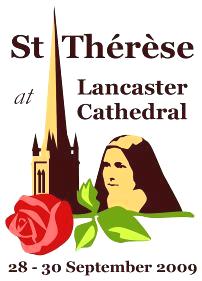|
See also:
More details:
|
|
Saint Thérèse of Lisieux in Lancaster 28th-30th September 2009 |
|
The Veneration of Relics: a practice for today
Fulfilling a human need When somebody dies, we often hold on to things that belonged to them. We wish to be reminded of those we loved who have left this world. We also treat their body with respect, and as Christians we recognise the human body as a dwelling-place of the Holy Spirit.
The veneration of relics comes from these human instincts. The saints – those who have died and now dwell with God in heaven - are members of the family of the Church, and we treat them with love as we would our own family. Items that belonged to the saints on earth are treasured as a reminder of their time in this life. Their bodies are particularly respected, as within these holy men and women the Lord Himself made a dwelling.
We live in an age of ‘secular relics’. Many people prize this or that item that once belonged to someone famous. It might be a footballer’s boots, an item of clothing worn by a celebrity or simply something marked with a famous person’s signature. Catholics venerate relics of the saints because we recognise the contribution they have made to the Church and the world. The saints are not just ‘famous people’; they have changed the world for the better.
Relics in Scripture The Old Testament records miracles associated with items which belonged to those who have died: a miracle was worked through the mantle of Elijah (see 2 Kings 2:14) and another through the bones of Elisha (2 Kings 13:21). In the New Testament handkerchiefs and clothing that had touched St Paul were brought to the sick so that they might be healed (Acts 19:11-12). Holy men and women – and things associated with them – became means by which God worked to help His people.
Some History There is evidence of the veneration of the human remains of St Polycarp (mid-2nd century AD), whose body was described as ‘more valuable than precious stones and finer than refined gold’. Relics became even more important in the days when the Eucharist was celebrated in the Catacombs, among the bodies of Christians. After attacks by the Iconoclasts, the Second Council of Nicaea (787AD) reaffirmed the value of relics and decreed that no church should be consecrated without them. This decree was reaffirmed after the Second Vatican Council, and relics are still placed in all consecrated altars, reminding us of the faith of earlier generations and encouraging us to follow them on the path to heaven.
At the execution of martyrs faithful people would often try to take something away as a relic. So it is that bones of some of the martyr saints have been preserved by the Church in each generation. In our own Diocese, there are accounts that people dipped their handkerchiefs in the blood of those who had been executed in Lancaster after the Reformation.
Pilgrimages Many tombs of the saints have become sites of pilgrimage. Amongst the most notable are the tombs of St James at Santiago de Compostela and the tomb of St Peter at the Vatican. Millions travel to these holy sites each year. Lisieux, where the relics of St Thérèse usually rest, has also become a site of pilgrimage. The Catechism speaks of the veneration of relics as a devotion which extends but does not replace the Liturgy of the Church. By venerating relics of the saints we express thanks to God, who gives us the saints as an example and an inspiration. The saints pray for us so that we may follow them on the way to eternal life.
From Scripture “Elisha took the mantle of Elijah that had fallen from him, and struck the water, saying ‘Where is the Lord, the God of Elijah?’ When he had struck the water, the water was parted to one side and to the other, and Elisha went over.” 2 Kings 2:14
“So Elisha died, and they buried him. Now the bands of the Moabites used to invade the land in the spring of the year. As a man was being buried, a marauding band was seen and the man was thrown into the grave of Elisha; as soon as the man touched the bones of Elisha, he came to life and stood on his feet.” 2 Kings 13:20-21
“God worked extraordinary miracles through Paul, so that when the handkerchiefs or aprons that had touched his skin were brought to the sick, their diseases left them, and the evil spirits came out of them.” Acts 19:11-12
From the Catechism “Besides sacramental liturgy and sacramentals, catechesis must take into account the forms of piety and popular devotions among the faithful. The religious sense of the Christian people has always found expression in various forms of piety surrounding the Church’s sacramental life, such as the veneration of relics, visits to sanctuaries, pilgrimages, processions, the stations of the cross, religious dances, the rosary, medals, etc. These expressions of piety extend the liturgical life of the Church, but do not replace it.” Catechism of the Catholic Church, nn. 1674-1675
This resource has been prepared in preparation for the visit of the relics of St Thérèse of Lisieux to Lancaster Cathedral (28-30 September 2009). It may be freely reproduced for any purpose associated with promoting the visit or providing catechesis in preparation for the visit.
You can also download this text (plus some other information about Thérèse’s relics)
More about the relics of St Thérèse can be found here. |

|
What’s in the reliquary? Click here for more info. |
